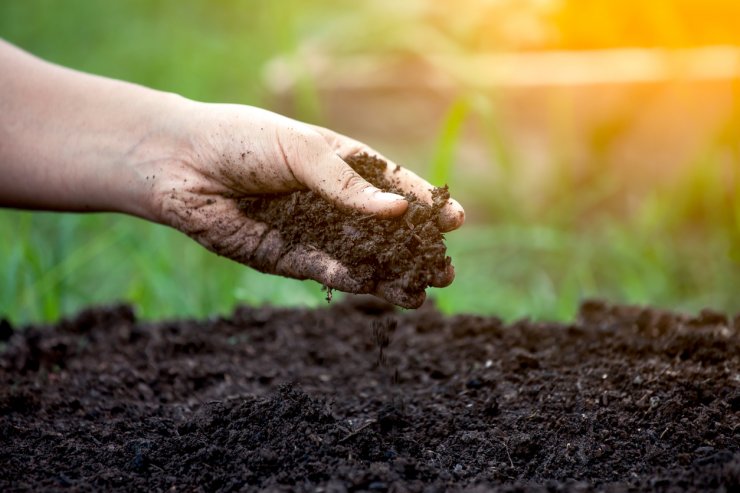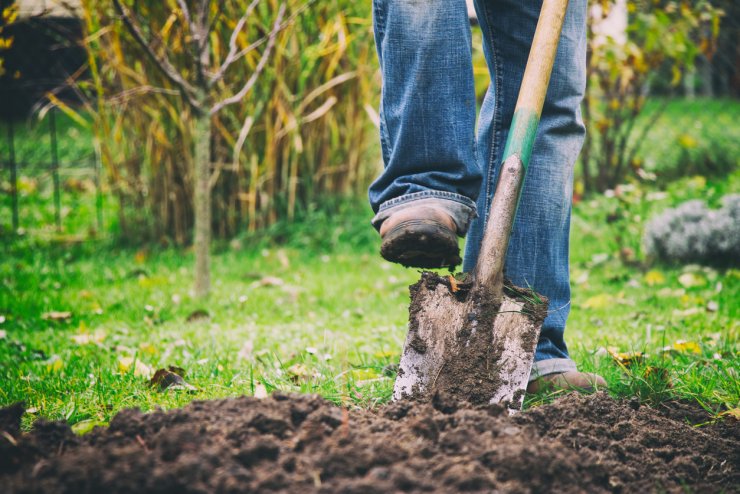
Picking up soil to test for pH
The first thing you should do is test your soil; you can do this yourself with a test kit, or take samples of your soil to your local garden center or extension service and have them test it for you.
- If the pH of your soil isn’t in the correct acidic range of 6 to 7, you’ll have to amend it to get it to the right balance. If your soil is too “sweet,” too alkaline for example, then you’ll need to add powdered sulfur to bring down the pH. Talk with your garden center or extension service about the exact amount you’ll need for the area where you’ll plant your peach. Your amount will vary depending on the overall type of soil you have in your garden.
Once you’ve adjusted your soil, you’ll need to let it sit for anywhere between two months to six months to let that change absorb and really settle in. In general, you should do this no later than in the fall before a spring planting.
Planting your peach tree

Digging a hole to plant peach tree
First, it’s a good idea to soak the roots of your tree for six to 12 hours before you plan on planting it.
-
- Tip: Peach trees are self-pollinating, meaning they don’t need a partner for bees to pollinate them. You only need to plant one if that’s all you want!
Once you’ve selected your spot, do some soil preparation. Rake and hoe the soil until it’s smooth on the surface and free from clumps and rocks. Prepare the soil as deep as you will be planting the tree.
Then dig a hole a few inches deeper and wider than the spread of the roots of your tree. Set the tree on top of a small mound of soil in the middle of the hole. Be sure to spread the roots away from the trunk without excessively bending them.
Refill the hole with half native soil and half mature compost mixed together. Remember to keep the graft scar (remember that?) 1 to 2 inches above the ground level (or 2 to 3 inches for dwarf trees). You should also be able to spot a slight curve in that scar: Position the tree so that the curve is away from the sun.
Do not fertilize your new peach tree upon planting. Do soak the area completely after planting, and make sure to keep the area around the tree weed free. A good layer of mulch is helpful for this.
In fact, it’s a good idea to remove the grass from around your tree for at least a couple of years to a width of 18 inches. This keeps the grass from competing with your tree for water and nutrients.
The next step is to trim the tree to about 12 to 36 inches in height. By taking off the top, you’re setting up the tree for the shape you want to achieve when it’s time to prune.
Water your tree deeply about once a week, even once it’s established. Remember, it doesn’t want to be too wet, so don’t get carried away if it’s been raining. Finally, about six weeks after planting, fertilize your tree, or trees, with a balanced (10-10-10) fertilizer. Apply fertilizer in a circle around the tree, but keep it at least 18 inches away from the trunk. This encourages the roots to spread outward, rather than turning in on themselves.
What type of soil do you use to grow your peaches? Have you tested the pH level in your soil? What are your best tips for creating optimal soil for your peaches? Please share your techniques with us.


 Previous
Previous

